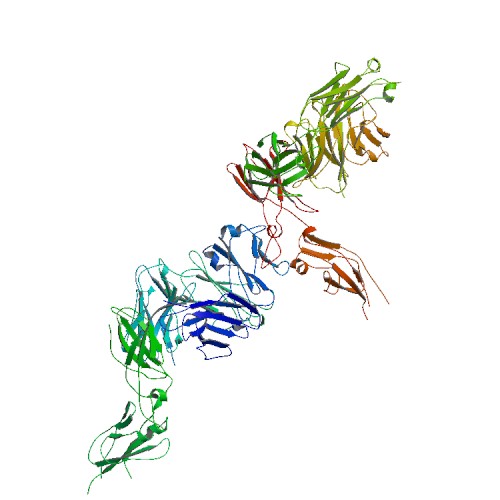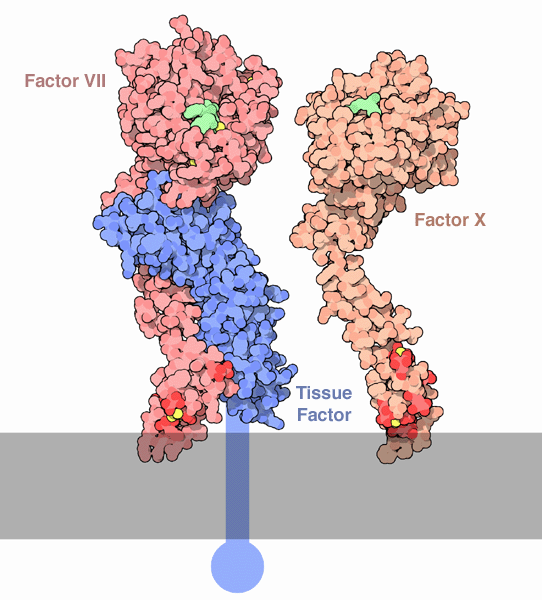Tissue factor
| Coagulation factor III (thromboplastin, tissue factor) | |||||||||||
|---|---|---|---|---|---|---|---|---|---|---|---|
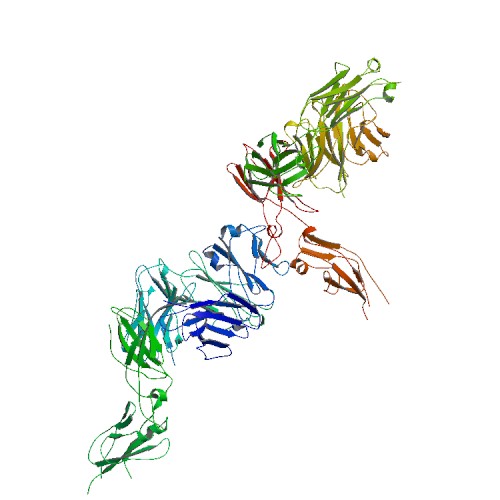 PDB rendering based on 1ahw. | |||||||||||
| Identifiers | |||||||||||
| Symbols | F3 ; CD142; TF; TFA | ||||||||||
| External IDs | Template:OMIM5 Template:MGI HomoloGene: 1511 | ||||||||||
| |||||||||||
| RNA expression pattern | |||||||||||
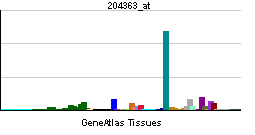 | |||||||||||
| More reference expression data | |||||||||||
| Orthologs | |||||||||||
| Template:GNF Ortholog box | |||||||||||
| Species | Human | Mouse | |||||||||
| Entrez | n/a | n/a | |||||||||
| Ensembl | n/a | n/a | |||||||||
| UniProt | n/a | n/a | |||||||||
| RefSeq (mRNA) | n/a | n/a | |||||||||
| RefSeq (protein) | n/a | n/a | |||||||||
| Location (UCSC) | n/a | n/a | |||||||||
| PubMed search | n/a | n/a | |||||||||
|
WikiDoc Resources for Tissue factor |
|
Articles |
|---|
|
Most recent articles on Tissue factor Most cited articles on Tissue factor |
|
Media |
|
Powerpoint slides on Tissue factor |
|
Evidence Based Medicine |
|
Clinical Trials |
|
Ongoing Trials on Tissue factor at Clinical Trials.gov Trial results on Tissue factor Clinical Trials on Tissue factor at Google
|
|
Guidelines / Policies / Govt |
|
US National Guidelines Clearinghouse on Tissue factor NICE Guidance on Tissue factor
|
|
Books |
|
News |
|
Commentary |
|
Definitions |
|
Patient Resources / Community |
|
Patient resources on Tissue factor Discussion groups on Tissue factor Patient Handouts on Tissue factor Directions to Hospitals Treating Tissue factor Risk calculators and risk factors for Tissue factor
|
|
Healthcare Provider Resources |
|
Causes & Risk Factors for Tissue factor |
|
Continuing Medical Education (CME) |
|
International |
|
|
|
Business |
|
Experimental / Informatics |
Editor-In-Chief: C. Michael Gibson, M.S., M.D. [1]
Tissue factor, also called thromboplastin, factor III or CD142 is a protein present in subendothelial tissue, platelets, and leukocytes necessary for the initiation of thrombin formation from the zymogen prothrombin. Thrombin formation ultimately leads to the coagulation of blood. This gene encodes coagulation factor III which is a cell surface glycoprotein. This factor enables cells to initiate the blood coagulation cascades, and it functions as the high-affinity receptor for the coagulation factor VII. The resulting complex provides a catalytic event that is responsible for initiation of the coagulation protease cascades by specific limited proteolysis. Unlike the other cofactors of these protease cascades, which circulate as nonfunctional precursors, this factor is a potent initiator that is fully functional when expressed on cell surfaces. There are 3 distinct domains of this factor: extracellular, transmembrane, and cytoplasmic. This protein is the only one in the coagulation pathway for which a congenital deficiency has not been described.[1]
Structure
The protein structure of TF consists of three domains:
- 1. a domain which is located outside the cell, this domain binds factor VIIa. The binding of VIIa to TF occurs via protein-protein interactions by both molecules.
- Factor VIIa is a protein which consists of several domains. One of these domains, the carboxylated GLA domain, binds in the presence of calcium to negatively charged phospholipids. Binding of VIIa to negatively charged phospholipids greatly enhances the protein-protein binding of VIIa to TF.
- 2. a domain which crosses the hydrophobic membrane.
- 3. a domain of 21 amino acids length inside the cell which is involved in the signaling function of TF.
Functions
Coagulation
TF is the cell surface receptor for the serine protease factor VIIa.
The best known function of tissue factor is its role in blood coagulation. The complex of TF with factor VIIa catalyzes the conversion of the inactive protease factor X into the active protease factor Xa.
Together with factor VII, tissue factor forms the tissue factor or extrinsic pathway of coagulation. This is opposed to the intrinsic (amplification) pathway which involves both activated factor IX and factor VIII. Both pathways lead to the activation of factor X (the common pathway) which combines with activated factor V in the presence of calcium and phospholipid to produce thrombin (thromboplastin activity).
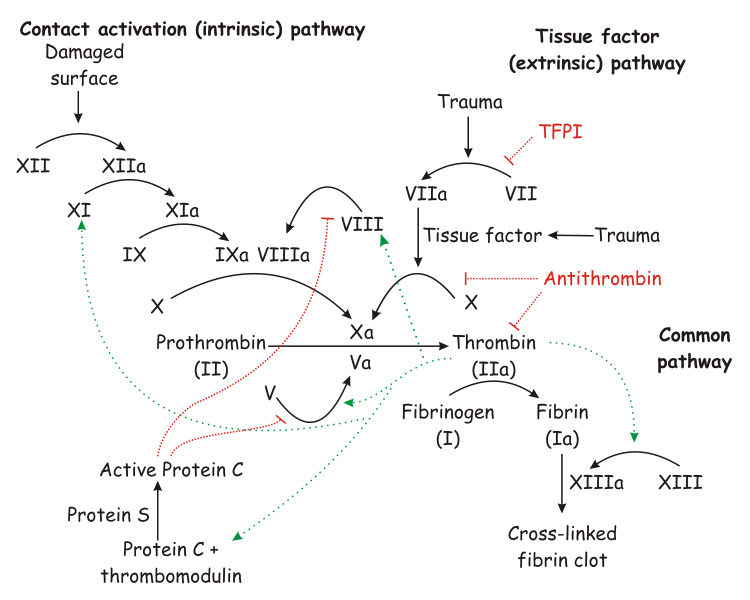
Cytokine
TF is related to a protein family known as the “cytokine receptor class II family”. The members of this receptor family are activated by cytokines. Cytokines are small proteins that can influence the behavior of white blood cells. Binding of VIIa to TF has also been found to start signaling processes inside the cell. The signaling function of TF/VIIa plays a role in angiogenesis and apoptosis.
Location
TF is expressed by cells which are normally not exposed to flowing blood such as sub-endothelial cells (e.g. smooth muscle cells) and cells surrounding blood vessels (e.g. fibroblasts). This can change when the blood vessel is damaged by for example physical injury or rupture of atherosclerotic plaques. Exposure of TF expressing cells during injury allows the complex formation of TF with factor VII. Factor VII and TF form an equal molar complex in the presence of calcium ions and this leads to the activation of factor VII on a membrane surface
The inner surface of the blood vessel consists of endothelial cells. Endothelial cells do not express TF except when they are exposed to inflammatory molecules such as tumor necrosis factor-alpha (TNF-alpha). Another cell type that expresses TF on the cell surface in inflammatory conditions is the monocyte (a white blood cell).
Additional images
-
Tissue factor
-
Tissue factor activation
References
Further reading
- Gouault-Helimann M, Josso F (1980). "[Initiation in vivo of blood coagulation. The role of white blood cells and tissue factor (author's transl)]". La Nouvelle presse médicale. 8 (40): 3249–53. PMID 392457.
- Mackman N (1995). "Regulation of the tissue factor gene". FASEB J. 9 (10): 883–9. PMID 7615158.
- McVey JH (2000). "Tissue factor pathway". Baillieres Best Pract. Res. Clin. Haematol. 12 (3): 361–72. PMID 10856975.
- Konigsberg W, Kirchhofer D, Riederer MA, Nemerson Y (2002). "The TF:VIIa complex: clinical significance, structure-function relationships and its role in signaling and metastasis". Thromb. Haemost. 86 (3): 757–71. PMID 11583305.
- Versteeg HH, Peppelenbosch MP, Spek CA (2002). "The pleiotropic effects of tissue factor: a possible role for factor VIIa-induced intracellular signalling?". Thromb. Haemost. 86 (6): 1353–9. PMID 11776298.
- Fernandez PM, Rickles FR (2003). "Tissue factor and angiogenesis in cancer". Curr. Opin. Hematol. 9 (5): 401–6. PMID 12172458.
- Golino P (2003). "The inhibitors of the tissue factor:factor VII pathway". Thromb. Res. 106 (3): V257–65. PMID 12356487.
- Engelmann B, Luther T, Müller I (2004). "Intravascular tissue factor pathway--a model for rapid initiation of coagulation within the blood vessel". Thromb. Haemost. 89 (1): 3–8. doi:10.1267/THRO03010003. PMID 12540946.
- Morrissey JH (2004). "Tissue factor: in at the start...and the finish?". J. Thromb. Haemost. 1 (5): 878–80. PMID 12871349.
- Yu JL, May L, Klement P; et al. (2004). "Oncogenes as regulators of tissue factor expression in cancer: implications for tumor angiogenesis and anti-cancer therapy". Semin. Thromb. Hemost. 30 (1): 21–30. doi:10.1055/s-2004-822968. PMID 15034795.
- Fernandez PM, Patierno SR, Rickles FR (2004). "Tissue factor and fibrin in tumor angiogenesis". Semin. Thromb. Hemost. 30 (1): 31–44. doi:10.1055/s-2004-822969. PMID 15034796.
- Mackman N (2004). "Role of tissue factor in hemostasis, thrombosis, and vascular development". Arterioscler. Thromb. Vasc. Biol. 24 (6): 1015–22. doi:10.1161/01.ATV.0000130465.23430.74. PMID 15117736.
- Belting M, Ahamed J, Ruf W (2005). "Signaling of the tissue factor coagulation pathway in angiogenesis and cancer". Arterioscler. Thromb. Vasc. Biol. 25 (8): 1545–50. doi:10.1161/01.ATV.0000171155.05809.bf. PMID 15905465.
- Engelmann B (2007). "Initiation of coagulation by tissue factor carriers in blood". Blood Cells Mol. Dis. 36 (2): 188–90. doi:10.1016/j.bcmd.2005.12.020. PMID 16473535.
- Furie B, Furie BC (2007). "Cancer-associated thrombosis". Blood Cells Mol. Dis. 36 (2): 177–81. doi:10.1016/j.bcmd.2005.12.018. PMID 16490369.
- Mackman N (2007). "Alternatively spliced tissue factor - one cut too many?". Thromb. Haemost. 97 (1): 5–8. PMID 17200762.
- Wiiger MT, Prydz H (2007). "The changing faces of tissue factor biology. A personal tribute to the understanding of the "extrinsic coagulation activation"". Thromb. Haemost. 98 (1): 38–42. PMID 17597988.
- Online Mendelian Inheritance in Man (OMIM) 134390
- PDB Molecule of the Month Tissue factor - March 2006
See also
de:Thromboplastin it:Fattore tissutale Template:WH Template:WikiDoc Sources
